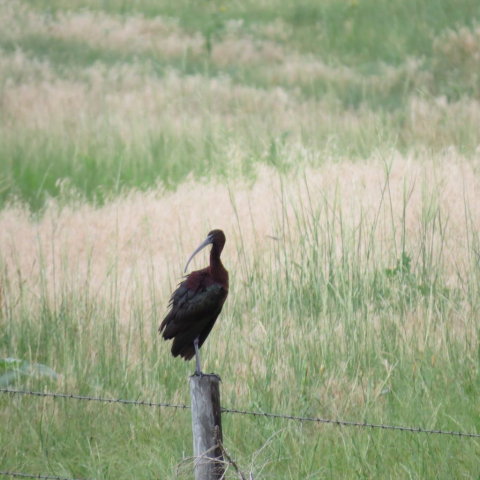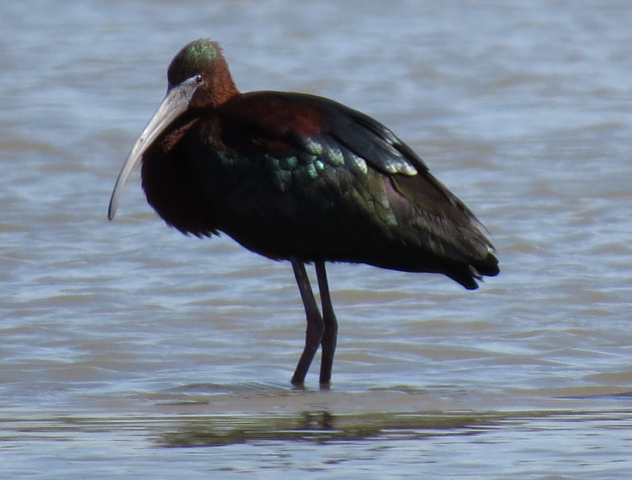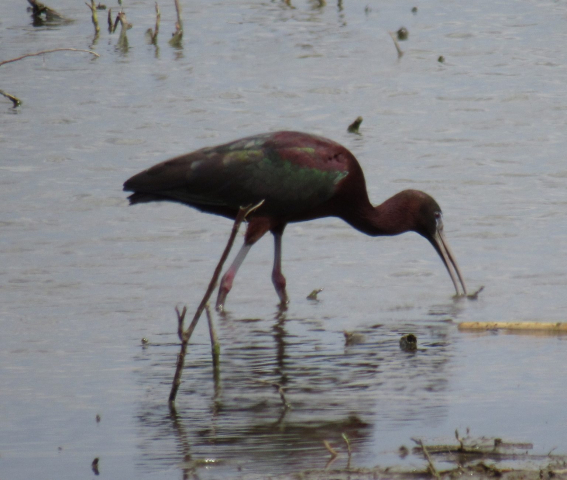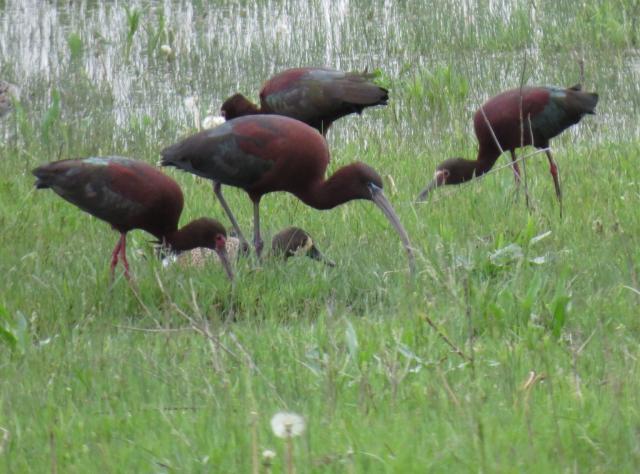Plegadis falcinellus
Status: Increasing. Uncommon regular spring migrant statewide. Rare casual breeder Rainwater Basin. Rare casual summer visitor west and southeast. Rare casual fall migrant east and central.
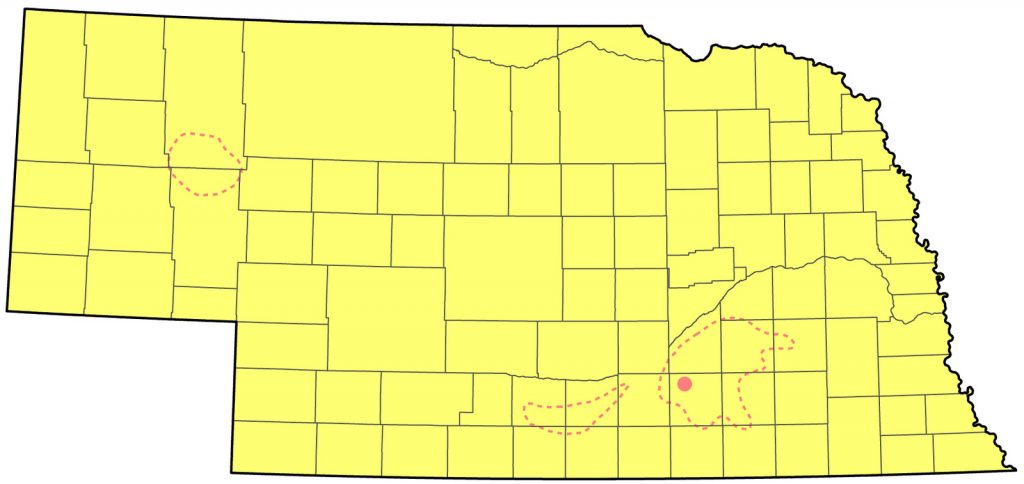
Documentation: Photograph: 15 Apr 2005 Harvard WPA, Clay Co (Brogie 2006).
Taxonomy: No subspecies are recognized (AviList 2025).
This species hybridizes extensively with White-faced Ibis. For further information, see https://birds.outdoornebraska.gov/glossy-x-white-faced-ibis-hybrid/.
Spring: Apr 18, 18, 19 <<<>>> May 26, 26, 29
Earlier dates are 11 Apr 2020 Clay Co, 14 Apr 2024 Douglas Co, and 15 Apr 2025 Lincoln Co.
A later date is 31 May 2024 Harrison WTP, Sioux Co. For later dates see Summer and Fall (below).
Later dates above are of birds presumed not to be breeding; Nebraska breeding records have been in association with breeding White-faced Ibis colonies, which begin breeding activities in early Jun.
This species is almost always associated with groups of and outnumbered by White-faced Ibis, during both migration and the breeding season. The vast majority of reports are in spring, when this species is easiest to identify relative to White-faced Ibis.
- High Counts: 6 at Harvard WPA, Clay Co 26 Apr 2020, and 4 at Ayr Lake, Adams Co 26 Apr 2021.
- A record 22 were reported in spring 2020.
Summer: Glossy Ibis arrived in North America from the Old World in the early 1800s, but it was not until the 1940s that rapid range expansion occurred north along the Atlantic Coast and west to Louisiana; in the 1980s, expansion occurred into Texas, where the first record was in 1983, and then northward in the Great Plains (Patten and Lasley 2000). Nebraska’s first state record was of an adult with a flock of 28 White-faced Ibis 24 Apr 1999 (Jorgensen 2012); the first Wyoming record was in 1992 (Faulkner 2010). Through 2015 there were about 73 additional records (Jorgensen and Silcock 2015).
All summer (Jun-early Jul) reports of Glossy Ibis have been in or near the Rainwater Basin and Sandhills. Jorgensen and Dinsmore (2005) and Jorgensen and Silcock (2015) reviewed the status of the species in Nebraska and suggested that its apparently limited distribution was probably linked to the distribution of observers, however habitat suitable for breeding of White-faced Ibis with which summering Glossy Ibis associate, is probably a major distributional determinant.
Although breeding had been suspected a few times when this species had been observed within breeding colonies of White-faced Ibis, proof was lacking until 2015, when three nests tended by adults were photographed at Harvard WPA 7 Jul (Jorgensen and Silcock 2015), the first confirmed breeding record for the state. Two prior reports were suggestive of breeding, but confirming evidence was not obtained: two adults were with 70+ White-faced Ibises at Harvard WPA 14-20 Jul 2001 (Jorgensen 2003, 2012, Dinsmore 2001), and two were with White-faced Ibises 12-14 Jun 2008 at Harvard WPA.
Additional summer reports (Jun-early Jul) are 3 Jun 2021 Green Wing WMA, Clay Co, 4 Jun 2024 North Platte, Lincoln Co, 11 Jun 2024 Crescent Lake NWR, Garden Co, 16 Jun 2022 Crescent Lake NWR, 20 Jun Harvard WPA, Clay Co (Brogie 2014), 21 Jun 2022 North Platte WTP, Lincoln Co, an adult in Fillmore Co 24 and 30 Jun 2010 (Brogie 2011), 9 Jul 2022 Box Butte Co, 11 Jul 2021 Lakeside, Sheridan Co, and 11 Jul 2022 Lakeside.
Fall: Migration probably is at the same time as White-faced Ibis, with southward movement beginning in Jul and peaking in Aug, although there are few data; individual Glossy Ibises in fall are difficult if not impossible to identify in the field.
Reports beginning in mid-Jul where breeding was not noted are 15-21 Jul 2001 Clay Co, 17 Jul 2023 Funk WPA, Phelps Co, one in Phelps Co 18 Jul 2011, an adult at Harvard WPA 20 Jul 2013 (Brogie 2014), 20 Jul 2019 Ellsworth, Sheridan Co, 20 Jul 2019 Lakeside, Sheridan Co, 24 Jul 2019 Logan Co, one at Straight Water WMA, Seward Co 9-16 Aug 2008, one near Goose Lake, Crescent Lake NWR 5-7 Aug 2021, one at Lakeside, Sheridan Co 6 Aug 2023, one at Straight Water WMA 13 Aug 2021, one at Kissinger Basin WMA, Clay Co 15 Aug 2011, a single in adult plumage well-studied at Hastings, Adams Co 19 Aug 2005, two adults at Jack Sinn WMA, Lancaster Co 21 Aug 2013 (Brogie 2014), two in the eastern Rainwater Basin 24 Aug 2008, an immature photographed at Tamora WPA, Seward Co 8 Sep 2017, and one at Funk WPA, Phelps Co 8 Sep 2023.
Comments: There are 11 additional reports in the literature, none convincingly documented. At least two are suggestive of this species, but are dated 1946 and 1964, well before the major expansion into the Great Plains began in the 1980s. Bruner et al (1904) listed three specimens attributed to Glossy Ibis, but Swenk (1918) noted that these immature birds could not be identified to species and dropped Glossy Ibis from the state list.
Images
Abbreviations
NWR: Mational Wildlife Refuge
WMA: Wildlife Management Area (State)
WPA: Waterfowl Production Area (Federal)
WTP: Water Treatment Plant
Literature Cited
AviList Core Team, 2025. AviList: The Global Avian Checklist, v2025. https://doi.org/10.2173/avilist.v2025.
Brogie, M.A. 2006. 2005 (17th) Report of the NOU Records Committee. NBR 74: 69-74.
Brogie, M.A. 2011. 2010 (22nd) Report of the NOU Records Committee. NBR 79: 99-111.
Brogie, M.A. 2014. 2013 (25th) Report of the NOU Records Committee. NBR 82: 131-146.
Bruner, L., R.H. Wolcott, and M.H. Swenk. 1904. A preliminary review of the birds of Nebraska, with synopses. Klopp and Bartlett, Omaha, Nebraska, USA.
Dinsmore, S.J. 2001. The Changing Seasons. North American Birds 55: 398-405.
Faulkner, D.W. 2010. Birds of Wyoming. Roberts and Company, Greenwood Village, Colorado, USA.
Gill, F., D. Donsker, and P. Rasmussen (Eds). 2022. IOC World Bird List (v 12.2). Doi 10.14344/IOC.ML.12.2. http://www.worldbirdnames.org/.
Jorgensen, J.G. 2003. 2001 (13th) Report of the NOU Records Committee. NBR 71: 97-102.
Jorgensen, J.G. 2012. Birds of the Rainwater Basin, Nebraska. Nebraska Game and Parks Commission, Lincoln, Nebraska, USA.
Jorgensen, J.G., and S.J. Dinsmore. 2005. An Assessment of the Status of White-Faced Ibis (Plegadis chihi) in the Great Plains. Natural Resource Ecology and Management Publications. Paper 45.
Jorgensen, J.G., and W.R. Silcock. 2015. First Nesting Record and Status Review of the Glossy Ibis in Nebraska. NBR 83: 139-149.
Patten, M.A., and G.W. Lasley. 2000. Range Expansion of the Glossy Ibis in North America. North American Birds 54: 241-247.
Swenk, M.H. 1918. Revisory notes on the birds of Nebraska. Wilson Bulletin 30: 112-117.
Recommended Citation
Silcock, W.R., and J.G. Jorgensen. 2025. Glossy Ibis (Plegadis falcinellus). In Birds of Nebraska — Online. www.BirdsofNebraska.org
Birds of Nebraska – Online
Updated 1 Aug 2025
